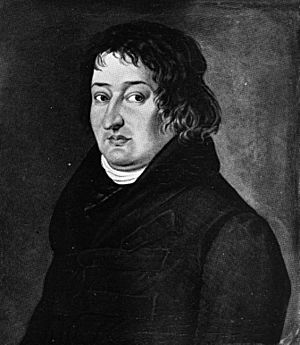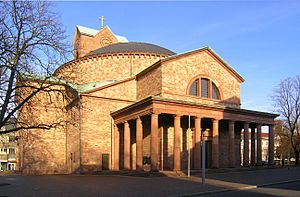Friedrich Weinbrenner facts for kids
Quick facts for kids
Friedrich Weinbrenner
|
|
|---|---|

Friedrich Weinbrenner
|
|
| Born | 24 November 1766 Karlsruhe, Margraviate of Baden
|
| Died | 1 March 1826 (aged 59) |
| Nationality | German |
| Occupation | Architect City planner |
Friedrich Weinbrenner (born November 24, 1766 – died March 1, 1826) was a famous German architect and city planner. He was well-known for his amazing work in the classical style. This style uses ideas from ancient Greek and Roman buildings.
Contents
Early Life and Learning
Friedrich Weinbrenner was born in a city called Karlsruhe. He started his career by learning from his father, who was a carpenter. This meant he learned how to build things from a young age.
In 1788, he worked as a builder in Zürich and Lausanne. These cities are in Switzerland. Later, in 1790, he moved to Vienna to study architecture. He mostly taught himself during this time.
He also studied at special building schools in Vienna and Dresden. From 1791 to 1792, he spent time in Berlin. Here, he learned about Palladian architecture. This is a style inspired by the Italian architect Andrea Palladio. It uses balanced shapes and classical designs.
From 1792 to 1797, Weinbrenner traveled in Italy. He studied many ancient buildings in places like Rome, Pompeii, and Herculaneum. He was especially interested in the old Greek temples at Paestum. He was one of the first German architects to see these very old buildings. Studying these ancient structures helped him develop his own unique style.
Designing Cities and Buildings
After his time in Italy, Weinbrenner worked for a short while in Strasbourg and Hanover. But he soon settled in Karlsruhe, his hometown. Here, he became the official architect for the city. He designed buildings for the government and for private people.
Karlsruhe was a new city, founded in 1715. It became the capital of the Grand Duchy of Baden. This was a powerful area in Germany at the time. Weinbrenner played a huge role in making Karlsruhe a beautiful city.
Many architects learned from Weinbrenner. In 1825, he helped start the Polytechnic School in Karlsruhe. This school taught new architects. Because of his students and his published works, a special "Weinbrenner style" of Classicism became popular.
Weinbrenner is famous for designing Karlsruhe as a "Classical city." He created a big plan for the city in 1797. This plan included a main road called the Triumphal Road. Along this road, he designed important buildings like the Protestant Church (1807–1815) and the City Hall (1821–1825). Sadly, many of Weinbrenner's buildings were damaged during Second World War. They were rebuilt in the 1950s.
Famous Buildings in Karlsruhe
Here are some of the important buildings Friedrich Weinbrenner designed in Karlsruhe:
- Karlsruhe Synagogue (1798–1800, later destroyed)
- Palace (1803–1814, partly rebuilt)
- Karlsruhe court theater (1804–1808, later burned down)
- Library (1805, destroyed in World War II)
- City Hall (1805/06 and 1821/25, rebuilt after war)
- Protestant Church (Stadtkirche), (1807–1816, rebuilt with a modern inside)
- St Stephan Catholic Church (1808–1814, rebuilt after war)
- Southern city gate (demolished later)
- Stephanienbad at Karlsruhe-Beiertheim (1811, now a church)
- Museum (1813–1814, later burned)
- Western city gate (1817–1821, partly destroyed in World War II, then removed)
- Ständehaus (1820–1822, destroyed in 1944)
- Mint (1826–1827)
Images for kids
See also
 In Spanish: Friedrich Weinbrenner para niños
In Spanish: Friedrich Weinbrenner para niños




